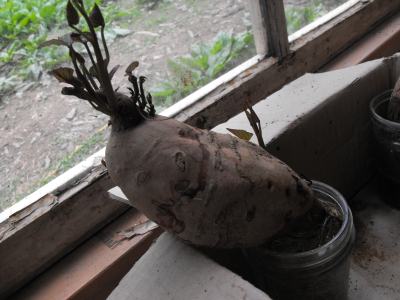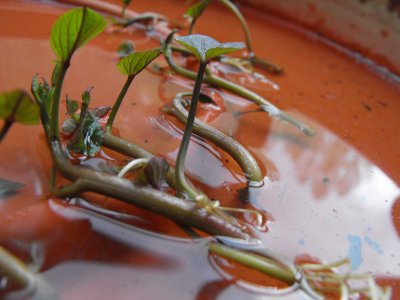
Sweet potato propagation
 Last
year, I thought I had sweet
potato slip production
figured out. My method was quite simple --- submerge about a
third of the potato in water, put the containers on a heat mat, break
off sprouts once they form, then put the slips in water to grow roots.
Last
year, I thought I had sweet
potato slip production
figured out. My method was quite simple --- submerge about a
third of the potato in water, put the containers on a heat mat, break
off sprouts once they form, then put the slips in water to grow roots.
My only complaint was
that starting the potatoes in early April meant I could only plant one
bed at the frost free date and had to put out the rest of the sweet
potatoes a bed or two at a time until early July. So this year I
started my sweet potatoes near the end of March...and the tubers sat
there doing nothing for a few weeks before over half of them rotted
away. We're still on schedule to plant a bed of slips this week
and will fill in all of the parts of the garden I'd allotted to sweet
potatoes, but we didn't get the jump on the season I'd hoped for.
Maybe March is just too early to start sweet potatoes?
 I
also think I blew it by focusing on big tubers for sprouting, compared
to the small tubers I used last year. Various extension service
websites suggest that the optimal sweet potato for sprouting is only an
inch and a half in diameter. Next year, I'll bypass those chunky
monsters and use mini-tubers as seed stock.
I
also think I blew it by focusing on big tubers for sprouting, compared
to the small tubers I used last year. Various extension service
websites suggest that the optimal sweet potato for sprouting is only an
inch and a half in diameter. Next year, I'll bypass those chunky
monsters and use mini-tubers as seed stock.
If I remember, I'd like
to try another alternative technique next year as well. The pros
start their sweet potatoes in hot beds of moist sand, and I think I can
mimic that on a small scale by putting a seed starting tray full of
sand on the heat pad instead of jars of water. I suspect the sand
would prevent this year's molding problems by keeping the tubers moist
but not wet.
On the plus side, I
discovered that chickens really enjoy half rotten sweet potatoes.
Maybe once we work the kinks out of our propagation method, sweet
potatoes will be a component of farm-grown
chicken feed?
| This post is part of our Farm Experiments lunchtime series.
Read all of the entries: |
Want more in-depth information? Browse through our books.
Or explore more posts by date or by subject.
About us: Anna Hess and Mark Hamilton spent over a decade living self-sufficiently in the mountains of Virginia before moving north to start over from scratch in the foothills of Ohio. They've experimented with permaculture, no-till gardening, trailersteading, home-based microbusinesses and much more, writing about their adventures in both blogs and books.
Want to be notified when new comments are posted on this page? Click on the RSS button after you add a comment to subscribe to the comment feed, or simply check the box beside "email replies to me" while writing your comment.

Assuming that the seed roots were not subjected to flooding in the previous production cycle, adventitious sprouts should appear when the temperatures are around 80-85F for at least 2 weeks, relative humidity is above 60%, and that the whole root is not submerged in water. These roots need to "breathe." Seed roots can be "preheated" (80F for about a week, >60% RH) in place prior to bedding. This should shorten the number of days between actual bedding and the appearance of sprouts.
Best of luck!